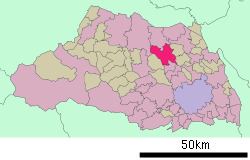Phone number 048-541-1321 Population 119,639 (2010) | Region Kantō Area 67.49 km² Local time Monday 8:40 AM | |
 | ||
Weather 11°C, Wind W at 14 km/h, 62% Humidity Points of interest Konosushi Kamiya Park, Ko Shrine, Shōgan‑ji Temple, Seseragi Park, Konosu Park | ||
Kōnosu (鴻巣市, Kōnosu-shi) is a city located in Saitama Prefecture, in the central Kantō region of Japan. As of 1 February 2016, the city had an estimated population of 118,087 and a population density of 1750 persons per km². Its total area was 67.44 square kilometres (26.04 square miles).
Contents
- Map of Konosu Saitama Prefecture Japan
- Geography
- Surrounding municipalities
- History
- Economy
- Education
- Railway
- Highway
- Local attractions
- Festivals
- Noted people from Knosu
- References
Map of Konosu, Saitama Prefecture, Japan
Geography
Located in east-central Saitama Prefecture, Kōnosu is on the central reaches of the Arakawa River.
Surrounding municipalities
Saitama Prefecture
History
Kōnosu-shuku was a post station on the Nakasendō highway during the Edo period. The modern town of Kōnosu was created within Kitaadachi District, Saitama with the establishment of the municipalities system on April 1, 1889. On July 1, 1954, Kōnosu annexed the neighboring villages of Mida, Tamamiya, Mamuro and Kasahara (from Kitasaitama District). On September 30, 1954 Kōnosu annexed the village of Jōkō, and was elevated to city status. On October 1, 2005 the villages of Kawasato and Fukiage were also annexed.
Economy
Plastics and electronic components manufacturing are the largest industries in Kōnosu.
Education
Kōnosu has 19 elementary schools, eight middle schools and three high schools, as well as one special education school. Previously the city housed a Brazilian school, Centro Educacional Canarinho.
Railway
Highway
Local attractions
Kōnosu earned the nickname "Doll Town" for its many "Hina Ningyō" (a type of Japanese doll) factories. Kōnosu is also called "Flower town". It has several flower markets, and many flowers purchased in Tokyo and throughout the Kantō region are grown in Kōnosu.
